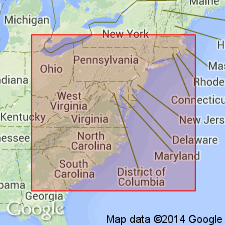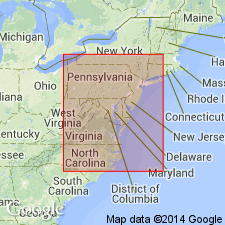
- Usage in publication:
-
- Aspers basalt
- Modifications:
-
- First used
- Dominant lithology:
-
- Basalt
- AAPG geologic province:
-
- Piedmont-Blue Ridge province
- Gettysburg basin
Summary:
A thin basalt flow near the top of the Gettysburg Formation in the vicinity of Aspers, PA, is here informally named the Aspers basalt. Above the Aspers, which may be as thick as 60 m (200 ft), are strata dated by palynomorphs as Early Jurassic.
Source: GNU records (USGS DDS-6; Reston GNULEX).

- Usage in publication:
-
- Aspers Basalt
- Modifications:
-
- Areal extent
- AAPG geologic province:
-
- Piedmont-Blue Ridge province
- Gettysburg basin
Summary:
A thin basalt unit overlying the Gettysburg Formation near Aspers, Adams Co., PA, is the Aspers Basalt. [This unit was called basalt near Bendersville by Stose and Bascom, 1929. They described a small sheet of basalt exposed in the road south of Bendersville, Adams Co., PA, consisting of a mixture of rounded diabase boulders in a red sandy matrix at the base, overlain by fine-grained diabase, decomposed but finely amygdaloidal in part. They believed it to be a small lava flow associated with the Gettysburg diabase sill.]
Source: GNU records (USGS DDS-6; Reston GNULEX).
For more information, please contact Nancy Stamm, Geologic Names Committee Secretary.
Asterisk (*) indicates published by U.S. Geological Survey authors.
"No current usage" (†) implies that a name has been abandoned or has fallen into disuse. Former usage and, if known, replacement name given in parentheses ( ).
Slash (/) indicates name conflicts with nomenclatural guidelines (CSN, 1933; ACSN, 1961, 1970; NACSN, 1983, 2005, 2021). May be explained within brackets ([ ]).

